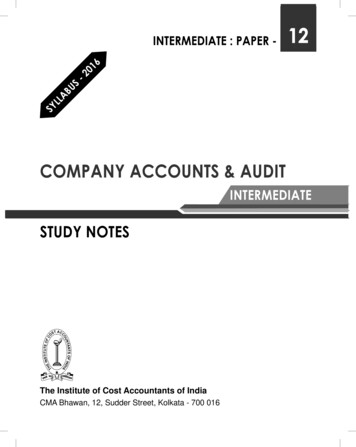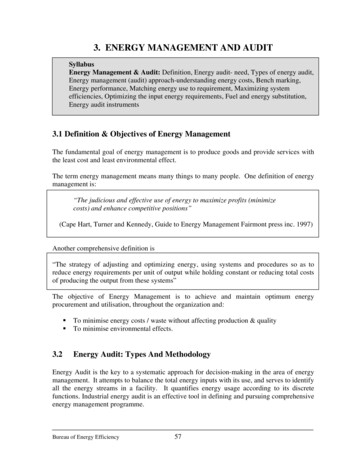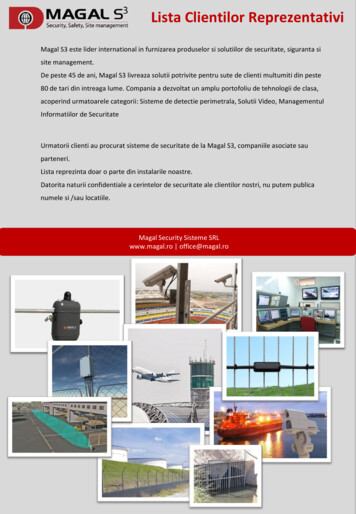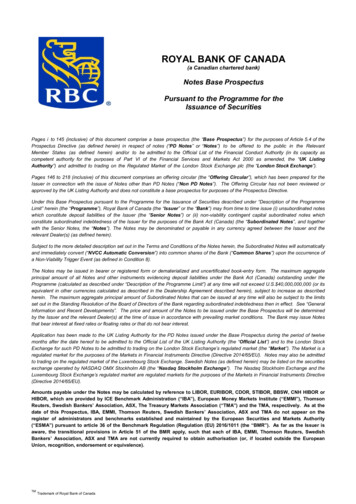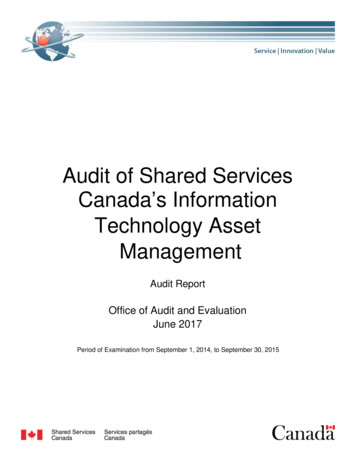
Transcription
Audit of Shared ServicesCanada’s InformationTechnology AssetManagementAudit ReportOffice of Audit and EvaluationJune 2017Period of Examination from September 1, 2014, to September 30, 2015
TABLE OF CONTENTSExecutive Summary . 1What we examined . 1Why it is important . 1What we found . 1Background. 2Objective . 3Scope . 3Methodology . 3Statement of Assurance . 3Detailed Findings and Recommendations . 4Shared Services Canada’s Information Technology Asset Management GovernanceStructure . 4Processes for the Lifecycle Management of Information Technology Assets . 5Information to Support the Lifecycle Management of Information Technology Assets . 6Monitoring of the Management of Information Technology Assets . 8Conclusion .10Management Response .11Annex A: Audit Criteria .12Annex B: Acronyms .13
Audit of Information Technology Asset ManagementExecutive SummaryWhat we examinedThe objective of the audit was to provide assurance on the adequacy of information technology(IT) asset management at Shared Services Canada (SSC) and to ensure compliance withgovernment policies and SSC procedures.The scope of the audit included SSC’s IT asset management (ITAM) processes, tools andcontrols including the application of these processes, tools and controls fromSeptember 1, 2014, to September 30, 2015.Why it is importantIT lifecycle management is the effective and efficient management of IT assets from theidentification of requirements to the disposal of the asset. IT assets include software, hardware,major projects and acquired services. ITAM depends on robust processes with tools toautomate manual processes.The Treasury Board (TB) Policy Framework for the Management of Assets and AcquiredServices set the tone for the management of assets and to help ensure that the conduct ofthese activities provided value for money and demonstrated sound stewardship in programdelivery. The complexity, speed, scale and concurrency of key transformation initiatives couldlead to unforeseen implementation and operational obstacles that could affect overall successof the transformation and ongoing service delivery which further emphasizes the importance ofhaving well established ITAM processes and controls.What we foundWe found that SSC developed a draft Framework for SSC Material “Inventory and Disposal”Management (Framework) and that the draft Framework and instruments were in line withapplicable requirements as set out in the TB Policy Framework for the Management of Assetsand Acquired Services and the TB Policy on Management of Materiel. The Framework and itsinstruments had not been approved or communicated.In the absence of an approved and communicated materiel management framework, we foundinsufficient communication regarding roles and responsibilities and the centralization of theITAM function.We identified several issues with the processes and controls that impacted SSC’s ability toprovide assurance that all enterprise assets (hardware and software) were being adequatelymanaged.We found gaps in the accuracy and sufficiency of the information available to support andmonitor the management of IT assets. There were inconsistencies in the identification of whatinformation was required for the lifecycle management of IT assets and the controls in place toensure the required information was captured in the appropriate tracking tool.We found no systematic monitoring taking place in relation to the overall management of ITassets at SSC.Patrice Prud’hommeChief Audit and Evaluation ExecutiveOffice of Audit and EvaluationShared Services Canada1
Audit of Information Technology Asset ManagementBackground1. Shared Services Canada (SSC) was established on August 4, 2011, to modernize how thefederal government manages its information technology (IT) infrastructure in order to bettersupport the delivery of programs and services to Canadians. The IT infrastructuresupporting government programs and services was aging, vulnerable to security risks andinefficient.2. The Treasury Board (TB) Policy Framework for the Management of Assets and AcquiredServices set the tone for the management of assets and helped ensure that the conduct ofthese activities provided value for money and demonstrated sound stewardship in programdelivery. The complexity, speed, scale and concurrency of key transformation initiativescould lead to unforeseen implementation and operational obstacles that could affect overallsuccess of the transformation and ongoing service delivery which further emphasizes theimportance of having well established IT asset management (ITAM) processes and controls.3. This audit was approved by the President of SSC after being recommended by theDepartmental Audit and Evaluation Committee as part of the 2014–2017 Risk-based Auditand 2014–2019 Evaluation Plan. SSC’s senior management also identified concerns aroundthe lack of documented and communicated roles and responsibilities for ITAM, the risksassociated with the transfer of legacy assets and not having timely, sufficient and accurateinformation on all of SSC’s IT assets.4. IT lifecycle management is the effective and efficient management of IT assets from theidentification of requirements to the disposal of the asset. IT assets include software,hardware, major projects and acquired services. ITAM depends on robust processes withtools to automate manual processes.5. Legacy refers to equipment or assets procured and owned by another governmentorganization before they were transferred to SSC in 2011, and enterprise refers to newassets and equipment that were procured with SSC funds since SSC was created.6. A new organizational structure for SSC was adopted on April 1, 2015, entitled SSC WayForward, to reflect SSC’s focus on the migration from legacy to new enterprise ITinfrastructure. The new structure made branches responsible for the entire lifecycle ofservices they provided. This realignment was part of SSC’s natural evolution and had animpact on several groups including the Service Asset and Configuration Management(SACM) directorate which was responsible for a large part of the ITAM function at SSC andgained more responsibility after the realignment.7. Prior to April 1, 2015, there were no standardized ITAM processes and tools in place for thelifecycle management of IT assets. Since the reorganization, the ITAM function becamecentralized under the SACM directorate.Office of Audit and EvaluationShared Services Canada2
Audit of Information Technology Asset ManagementObjective8. The objective of the audit was to provide assurance on the adequacy of ITAM at SSC and toensure compliance with government policies and SSC procedures.Scope9. The scope of the audit included SSC’s ITAM processes, tools and controls including theapplication of these processes, tools and controls from September 1, 2014, toSeptember 30, 2015. This included the management of: All SSC IT assets, including hardware and software; and Both legacy and end-state assets. Consideration was given to the added value ofaddressing issues and risk related to legacy assets.Methodology10. During the conduct of the audit, we: Interviewed relevant directors, managers and technical experts; Conducted file and system walkthroughs and reviews; Reviewed relevant documents, such as TB and SSC policies, draft Framework forSSC Materiel “Inventory and Disposal” Management, and SSC processes andprocedures documentation; and Performed data analysis based on extracts provided from two systems used.11. Field work for this audit was substantially completed by October 2015.Statement of Assurance12. Sufficient and appropriate procedures were performed and evidence gathered to support theaccuracy of the audit conclusion. The audit findings and conclusion were based on acomparison of the conditions that existed as of the date of the audit, against establishedcriteria that were agreed upon with management. This engagement was conducted inaccordance with the Internal Auditing Standards for the Government of Canada and theInternational Standards for the Professional Practice of Internal Auditing. A practiceinspection has not been conducted.Office of Audit and EvaluationShared Services Canada3
Audit of Information Technology Asset ManagementDetailed Findings and RecommendationsShared Services Canada’s Information Technology Asset ManagementGovernance Structure13. We expected SSC to have a governance structure in place to ensure that IT assets weremanaged appropriately and in compliance with Government of Canada and SSC policies.Furthermore, we expected that there would be a documented, approved and communicatedmateriel management framework in place.14. We found that SSC developed a draft Framework for SSC Material “Inventory and Disposal”Management (Framework). The Framework included the following instruments: Draft Directive for SSC Materiel “Inventory and Disposal” Management; Draft Standard for SSC Materiel Inventory Control; Draft Standard for SSC Materiel Stocktaking; Draft Standard for SSC Materiel Transfer, Loan and Donation; Draft Standard for SSC Materiel Disposal; and Materiel Management Governance Structure.15. We found that the draft Framework and instruments were in line with applicablerequirements as set out in the TB Policy Framework for the Management of Assets andAcquired Services and the TB Policy on Management of Materiel.16. We expected that the roles and responsibilities for the management of IT assets would bedocumented and communicated. We found the roles and responsibilities for themanagement of IT assets were documented in the draft Framework and the accompanyingDirective, Standards and Materiel Management Governance Structure. However, at thetime of this audit the Framework had not yet been approved. Once approved, the intentionwas to communicate the Framework organization-wide on the SSC website. At the time ofthe audit, no communication plan had been developed.17. We found that stakeholders were consulted and improvements were made to theFramework to reflect the comments received throughout the consultation process.18. We found delays in the submission and presentation of the Framework for approval to theCorporate Management Board which was in most part due to the reorganization andconsultations with various stakeholders.19. The TB Policy on Management of Materiel stated that Deputy Heads were responsible forensuring that a materiel management framework was in place to ensure that materiel wasmanaged by departments in a sustainable and financially responsible manner. Furtherdelays in the approval, communication and implementation of the Framework would resultin non-compliance with TB requirements. Furthermore, the absence of a documented andcommunicated governance structure for ITAM could impact the Department’s operationalability to manage the lifecycle of its IT assets and damage its reputation as a responsiblesteward of crown property.Office of Audit and EvaluationShared Services Canada4
Audit of Information Technology Asset ManagementRecommendation 1The Senior Assistant Deputy Minister, Corporate Services, and Chief FinancialOfficer, should ensure the Framework for SSC Materiel “Inventory and Disposal”Management is approved, implemented and communicated.Management response:Management agrees with this recommendation. The Materiel Management Framework wasreviewed by the Senior Management Board in December 2015 and approved by thePresident of SSC in April 2016. A communique will be sent to SSC employees in July 2016to announce the approval of the Materiel Management Framework.Processes for the Lifecycle Management of Information Technology Assets20. We expected that SSC would have processes in place for the lifecycle management of ITassets which met the applicable policies and directives. We found that since thereorganization on April 1, 2015, SSC centralized its ITAM function under the responsibility ofSACM.21. We found that SSC had some documented processes and controls for the purchasing,receiving, tagging, recording and disposing of IT assets. However, these processes weremainly designed for use within SACM and were only communicated to the group internally.Although the SACM directorate was using their documented processes, updates wererequired to reflect organizational changes and general updates. For example, the disposalprocesses required updates to reflect additional types of disposal that had not beenpreviously documented and the user guide for the Enterprise Control Desk (ECD) trackingtool also required updates to align with the latest version of the software that was in use.22. In the absence of an approved and communicated materiel management framework, wefound there had been insufficient communication regarding the centralization of the ITAMfunction. There were no controls in place to enforce SACM’s involvement in the ITAMfunction. Therefore, SSC employees may not be aware of the requirement to contact ITAMat different points in the lifecycle.23. Prior to the centralization of the ITAM function, there were no standard processes ortracking tools which resulted in a lack of visibility of all IT assets that were transferred toSSC when the Department was established. As a result, we found that SSC could notprovide assurance that all of SSC’s legacy IT assets were adequately managed.24. There was no integration between the financial system (SIGMA) and the IT asset trackingtools (ECD and HP Asset Manager). SACM had documented a manual process to monitorSIGMA for new IT asset purchases because there was no assurance that SACM wasnotified when new IT assets were purchased. Due to the manual nature of this process andthe reliance on proper financial coding, there was a risk that all newly purchased IT assetsmay not be identified through this process.Office of Audit and EvaluationShared Services Canada5
Audit of Information Technology Asset Management25. We found that SSC’s process for tracking infrastructure software (the server and networksoftware found in data centres) was in the development stage and SSC was not able toreport on the infrastructure software currently deployed, including the status of the licensespurchased or issued. In addition, although there was a project underway to identify andaddress the gaps for certain desktop software, there was no control in place to prevent SSCfrom issuing more desktop software licenses than were purchased. Overall, SSC wasunable to provide assurance that the lifecycle of all software assets was appropriatelymanaged.26. Without awareness of all the assets that the Department owns (legacy and enterprise), SSCis not able to ensure that it is effectively managing the lifecycle of all of its IT assets.Recommendation 2The Senior Assistant Deputy Minister, Service Delivery and Management, shouldupdate SSC’s Information Technology Asset Management (ITAM) processes forall information technology assets and develop and implement a communicationplan to inform SSC employees outside of Service Asset and ConfigurationManagement of their roles and responsibilities pertaining to ITAM.Management response:SSC management agrees with the recommendation. Service Management will update ITAMprocesses for all IT assets. A communications plan will be developed to inform SSCemployees of their roles and responsibilities related to ITAM.Recommendation 3The Senior Assistant Deputy Minister (SADM), Corporate Services, and ChiefFinancial Officer, and SADM, Service Delivery and Management, shouldimplement effective controls to ensure that procured information technologyassets are recorded, managed and disposed of in accordance with SSCprocedures.Management response:Management agrees with the recommendation. The SADM, Corporate Services, and ChiefFinancial Officer, and the SADM, Service Delivery and Management, will coordinate effortsand implement effective controls to ensure that procured IT assets are recorded, managedand disposed of in accordance with SSC procedures. SSC will implement effective controlsthat include integration between the financial system and IT asset tracking tools.Information to Support the Lifecycle Management of Information TechnologyAssets27. We expected SSC to have accurate and sufficient information to support the management ofIT assets throughout their lifecycle. However, we found problems in the accuracy andsufficiency of the information available to support the management of IT assets.Office of Audit and EvaluationShared Services Canada6
Audit of Information Technology Asset Management28. SSC used two different software systems for the lifecycle management of IT assets(i.e. ECD and HP Asset Manager). ECD was used to track enterprise assets whichconsisted namely of: infrastructure hardware, servers, networks, switches, etc. HP AssetManager was used for legacy hardware, as well as for desktops, laptops, software and otherend-user assets.29. SACM identified and documented, through business rules, which fields and information wererequired to track and manage the lifecycle of IT assets. Reports were generated from theECD and HP Asset Manager databases containing all SSC assets up to June 30, 2015,were reviewed as part of the audit. We compared this data to the information identified asrequired by SACM.30. We found some controls in place to help ensure the required information collected wasaccurate and sufficient. However, there were several weaknesses identified in the controlsthat impacted the accuracy and sufficiency of the information captured in both tools: The business rules were very general and did not specify which specific field(s) ineither system should be populated (e.g. the business rules state “Location” isrequired, but there are multiple fields in the systems that contain location-typeinformation); There was additional information identified as important by SACM that was notcaptured in the business rules; and There were automated, system enforced controls for the collection of some requiredinformation, but not all.31. In addition, we identified weaknesses with some of the automated controls in the tools: Generic options were available in system enforced drop-down fields, such as“Please Select a Value” or “Unknown”; and Certain required fields allowed a blank entry.32. We found that the location fields (i.e. codes, descriptions, tower, floor and room) were notenforced in ECD and although some location fields were enforced in HP Asset Manager,there were cases where the combined information populated in the location fields in bothsystems did not provide accurate or sufficient information to locate some assets.33. After finding the above inconsistencies with location fields in ECD, we conducted aninventory validation exercise at one SSC location. We found that: Of the assets that were visible (i.e. in hallways and boardrooms), there were60 assets that were required to be tagged and tracked in the system; 35 of 60 (58%) assets should have had asset tags but either did not or they werenot visible; Of the 25 asset tags we identified, 18 were SSC tags and 6 were Public Works andGovernment Services Canada tags; and Only one asset was found in ECD and none in HP Asset Manager.34. These observations could have been due to a combination of timing and lack of acentralized ITAM function when SSC was created. SSC did not have its own asset tags atthe outset which resulted in assets being tagged with other department tags (even if theywere considered SSC assets). In addition, there were no centralized processes, tools orcontrols in place to track any assets that were tagged even after SSC received their ownasset tags.Office of Audit and EvaluationShared Services Canada7
Audit of Information Technology Asset Management35. The lack of visibility of all IT assets combined with the process and control weaknessesresulted in SSC’s inability to provide accurate and sufficient information to monitor themanagement of all IT assets throughout their lifecycle.Recommendation 4The Senior Assistant Deputy Minister, Service Delivery and Management, shouldconfirm the information required to manage the lifecycle of information technologyassets, update the business rules to be consistent with this information andensure proper controls are in place to ensure that the information is beingcaptured in a consistent and accurate manner.Management response:Management agrees with the recommendation. Information required to support IT lifecyclemanagement will be reviewed, and business rules will be updated to support consistent andaccurate asset tracking. SSC is committed to making the necessary changes to IT assetmanagement tools and processes in support of effective IT asset management.Monitoring of the Management of Information Technology Assets36. We expected that SSC would have mechanisms in place for monitoring and reporting on themanagement of IT assets. TB Policy Framework for the Management of Assets andAcquired Services required Deputy Heads to ensure that practices were in place for assetmanagement within the department and that monitoring and reporting on the managementof materiel occurred.37. We found that SSC’s draft Framework stated that the Chief Information Officer (CIO) wasresponsible for developing, maintaining, implementing measurement indicators and datacollection tools for the Framework and for reporting on them. However, we found nosystematic monitoring was taking place in relation to the overall management of IT assets atSSC; the CIO planned to develop metrics once the Framework was approved.38. A delay in the approval of the Framework was impeding the development of metrics,indicators and the reporting of these indicators affecting the ability of the Deputy Head tomonitor and report on the management of materiel at SSC and results in non-compliancewith TB requirements.Recommendation 5The Senior Assistant Deputy Minister, Corporate Services, and Chief FinancialOfficer, should ensure that measurement indicators are developed for monitoringand reporting on the Framework for SSC Materiel “Inventory and Disposal”Management.Office of Audit and EvaluationShared Services Canada8
Audit of Information Technology Asset ManagementManagement response:Management agrees with this recommendation. Measurement indicators will be developedfor monitoring and reporting on SSC’s Materiel Management Governance Structure (InternalPolicy Instruments: Directive and Standards associated to inventory control, stocktaking,transfer, loan, donation and disposal).Office of Audit and EvaluationShared Services Canada9
Audit of Information Technology Asset ManagementConclusion39. The objective of the audit was to provide assurance on the adequacy of ITAM at SSC and toensure compliance with government policies and SSC procedures.40. We found that SSC developed a draft Framework for SSC Material “Inventory and Disposal”Management and that the Framework and instruments were in line with applicablerequirements as set out in the TB Policy Framework for the Management of Assets andAcquired Services and the TB Policy on Management of Materiel. However, it was neitherapproved nor communicated.41. We found that stakeholders were consulted and improvements were made to theFramework to reflect the comments received throughout the consultation process. However,there had been insufficient communication regarding roles and responsibilities and thecentralization of the ITAM function.42. We identified several issues with the processes and controls that impacted SSC’s ability toprovide assurance that all enterprise assets (hardware and software) were being adequatelymanaged. Without awareness of all the assets that the Department owns (legacy andenterprise), SSC is not able to ensure that it is effectively managing the lifecycle of all of itsassets.43. We found deficiencies in the accuracy and sufficiency of the information available to supportand monitor the management of IT assets. There were inconsistencies in the identification ofwhat information was required for the lifecycle management of IT assets and the controls inplace to ensure the required information was captured in the appropriate tracking tool.44. We found that there was no systematic monitoring taking place in relation to the overallmanagement of IT assets at SSC; the CIO planned to develop metrics once the Frameworkwas approved.Office of Audit and EvaluationShared Services Canada10
Audit of Information Technology Asset ManagementManagement ResponseOverall Management ResponseManagement agrees with all the findings, conclusions, and recommendations. Actions will betaken to ensure compliance with the TB Policy Framework for the Management of Assets andAcquired Services and the TB Policy on Management of Materiel.Clear roles and responsibilities will be communicated in parallel to the implementation of theMaterial Management Internal Policy Instruments (Directive and Standards) associated withinventory control, stocktaking, transfer, loan, donation and disposal.While there are existing processes and controls in place, SSC’s ITAM processes for all ITassets will be developed and a communication plan will be implemented to inform SSCemployees outside of SACM of their roles and responsibilities pertaining to ITAM.Office of Audit and EvaluationShared Services Canada11
Audit of Information Technology Asset ManagementAnnex A: Audit CriteriaThe following audit criteria were used in the conduct of this audit:1. SSC has a governance structure in place to ensure that IT assets are managedappropriately and in compliance with Government of Canada and SSC policies.2. SSC has processes in place for the lifecycle management of IT assets which meet theapplicable policies and directives.3. SSC tracks its IT assets throughout their lifecycle and has access to accurate andsufficient information.Office of Audit and EvaluationShared Services Canada12
Audit of Information Technology Asset ManagementAnnex B: AcronymsAcronymName in FullCIOChief Information OfficeECDEnterprise Control DeskITInformation technologyITAMInformation Technology Asset ManagementSACMService Asset Configuration ManagementSSCShared Services CanadaTBTreasury BoardOffice of Audit and EvaluationShared Services Canada13
impact on several groups including the Service Asset and Configuration Management (SACM) directorate which was responsible for a large part of the ITAM function at SSC and gained more responsibility after the realignment. 7. Prior to April 1, 2015, there were no standardized ITAM processes and tools in place for the lifecycle management of IT .








